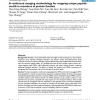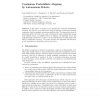160 search results - page 4 / 32 » Merging maps of multiple robots |
BMCBI
2006
13 years 7 months ago
2006
Background: Members of a protein family often have highly conserved sequences; most of these sequences carry identical biological functions and possess similar three-dimensional (...
JAMIA
2011
12 years 10 months ago
2011
Background Systematic study of clinical phenotypes is important for a better understanding of the genetic basis of human diseases and more effective gene-based disease management....
ISER
1999
Springer
13 years 11 months ago
1999
Springer
In this paper, we present a new approach for continuous probabilistic mapping. The objective is to build metric maps of unknown environments through cooperation between multiple au...
IROS
2006
IEEE
14 years 1 months ago
2006
IEEE
Abstract— This paper presents a new approach to the multirobot map-alignment problem that enables teams of robots to build joint maps without initial knowledge of their relative ...
ASYNC
1999
IEEE
13 years 11 months ago
1999
IEEE
We describe an extension of the virtual volume concept to multiple sensors. Data from multiple sensors are combined in real-time and mapped into a constantly updating three-dimens...


